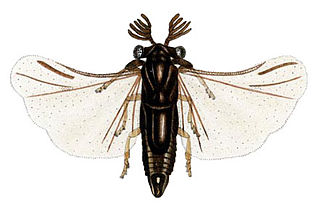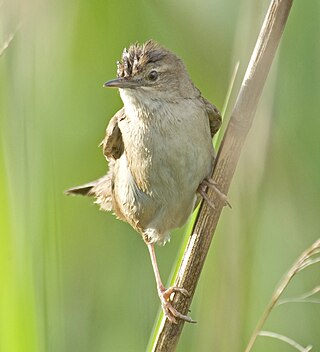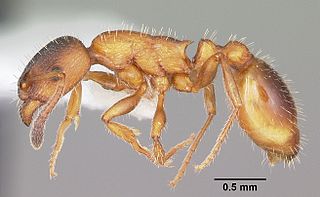
The Strepsiptera are an order of insects with eleven extant families that include about 600 described species. They are endoparasites of other insects, such as bees, wasps, leafhoppers, silverfish, and cockroaches. Females of most species never emerge from the host after entering its body, finally dying inside it. The early-stage larvae do emerge because they must find an unoccupied living host, and the short-lived males must emerge to seek a receptive female in her host. They are believed to be most closely related to beetles, from which they diverged 300–350 million years ago, but do not appear in the fossil record until the mid-Cretaceous around 100 million years ago.

Orthoptera is an order of insects that comprises the grasshoppers, locusts, and crickets, including closely related insects, such as the bush crickets or katydids and wētā. The order is subdivided into two suborders: Caelifera – grasshoppers, locusts, and close relatives; and Ensifera – crickets and close relatives.

Velvet ants (Mutillidae) are a family of more than 7,000 species of wasps whose wingless females resemble large, hairy ants. Their common name velvet ant refers to their resemblance to an ant, and their dense pile of hair, which most often is bright scarlet or orange, but may also be black, white, silver, or gold. Their bright colors serve as aposematic signals. They are known for their extremely painful stings,, and has resulted in the common name "cow killer" or "cow ant" being applied to the species Dasymutilla occidentalis. However, mutillids are not aggressive and sting only in defense. In addition, the actual toxicity of their venom is much lower than that of honey bees or harvester ants. Unlike true ants, they are solitary, and lack complex social systems.

Savi's warbler is a species of Old World warbler in the grass warbler genus Locustella. It breeds in Europe and the western Palearctic. It is migratory, wintering in northern and sub-Saharan Africa.

Histeridae is a family of beetles commonly known as clown beetles or hister beetles. This very diverse group of beetles contains 3,900 species found worldwide. They can be easily identified by their shortened elytra that leaves two of the seven tergites exposed, and their geniculate (elbowed) antennae with clubbed ends. These predatory feeders are most active at night and will fake death if they feel threatened. This family of beetles will occupy almost any kind of niche throughout the world. Hister beetles have proved useful during forensic investigations to help in time of death estimation. Also, certain species are used in the control of livestock pests that infest dung and to control houseflies. Because they are predacious and will even eat other hister beetles, they must be isolated when collected.

Ensifera is a suborder of insects that includes the various types of crickets and their allies including: true crickets, camel crickets, bush crickets or katydids, grigs, weta and Cooloola monsters. This and the suborder Caelifera make up the order Orthoptera. Ensifera is believed to be a more ancient group than Caelifera, with its origins in the Carboniferous period, the split having occurred at the end of the Permian period. Unlike the Caelifera, the Ensifera contain numerous members that are partially carnivorous, feeding on other insects, as well as plants.

Myrmecophilus or ant crickets, is a genus of orthopteran insects in the family Myrmecophilidae. This genus contains the majority of myrmecophilous (ant-loving) species in this small, obscure family.

Paratrechina is one of seven ant genera in the Prenolepis genus-group from the subfamily Formicinae. Six species are included in Paratrechina; one of which, the longhorn crazy ant, is a widespread, pantropical pest.

Ant mimicry or myrmecomorphy is mimicry of ants by other organisms; it has evolved over 70 times. Ants are abundant all over the world, and potential predators that rely on vision to identify their prey, such as birds and wasps, normally avoid them, because they are either unpalatable or aggressive. Some arthropods mimic ants to escape predation, while some predators of ants, especially spiders, mimic them anatomically and behaviourally in aggressive mimicry. Ant mimicry has existed almost as long as ants themselves; the earliest ant mimics in the fossil record appear in the mid-Cretaceous alongside the earliest ants.

The gyne is the primary reproductive female caste of social insects. Gynes are those destined to become queens, whereas female workers are typically barren and cannot become queens. Having a queen is what makes a "queenright" hive, nest, or colony of eusocial insects. A colony with multiple queens is said to be a polygyne form, whereas one with only one is a monogyne form.

Nothomyrmecia, also known as the dinosaur ant or dawn ant, is an extremely rare genus of ants consisting of a single species, Nothomyrmecia macrops. These ants live in South Australia, nesting in old-growth mallee woodland and Eucalyptus woodland. The full distribution of Nothomyrmecia has never been assessed, and it is unknown how widespread the species truly is; its potential range may be wider if it does favour old-growth mallee woodland. Possible threats to its survival include habitat destruction and climate change. Nothomyrmecia is most active when it is cold because workers encounter fewer competitors and predators such as Camponotus and Iridomyrmex, and it also increases hunting success. Thus, the increase of temperature may prevent them from foraging and very few areas would be suitable for the ant to live in. As a result, the IUCN lists the ant as Critically Endangered.

The red-billed buffalo weaver is a species of bird in the family Ploceidae. It is found in eastern and southern Africa. Its natural habitat is the dry savanna.

Harpagoxenus sublaevis is a species of ant in the subfamily Myrmicinae. It is found in Austria, France, Germany, Italy, and Switzerland.

A wasp is any insect of the narrow-waisted suborder Apocrita of the order Hymenoptera which is neither a bee nor an ant; this excludes the broad-waisted sawflies (Symphyta), which look somewhat like wasps, but are in a separate suborder. The wasps do not constitute a clade, a complete natural group with a single ancestor, as bees and ants are deeply nested within the wasps, having evolved from wasp ancestors. Wasps that are members of the clade Aculeata can sting their prey.

Crickets are orthopteran insects which are related to bush crickets, and, more distantly, to grasshoppers. In older literature, such as Imms, "crickets" were placed at the family level, but contemporary authorities including Otte now place them in the superfamily Grylloidea. The word has been used in combination to describe more distantly related taxa in the suborder Ensifera, such as king crickets and mole crickets.

The longhorn crazy ant, also known as the black crazy ant, is a species of small Formicine ant. These ants are commonly called "crazy ants" because instead of following straight lines, they dash around erratically. They have a broad distribution, including much of the tropics and subtropics, and are also found in buildings in more temperate regions, making them one of the most widespread ant species in the world. This species, as well as all others in the ant subfamily Formicinae, cannot sting. However, this species can fire/shoot a formic acid spray from its abdomen when under attack by other insects or attacking other insects. When the longhorn crazy ant bends its abdomen while aiming at an enemy insect, it is typically shooting its hard-to-see acid.

Leptothorax acervorum is a small brown to yellow ant in the subfamily Myrmicinae. It was first described by Johan Christian Fabricius in 1793. L. acervorum is vastly distributed across the globe, most commonly found in the coniferous forests of Central, Western and Northern Europe. The morphology of L. acervorum is extremely similar to that of other Leptothorax ants. The difference arises in the two-toned appearance of L. acervorum, with the head and metasoma being darker than the mesosoma segment of the body, and hair across its body. Following Bergmann's rule—unusually, for ectothermic animals—body size increases with latitude.
Myrmecophilus americanus is an ant cricket, a wingless cricket that is an obligate parasite of ants and lives in their nests.

Camponotus herculeanus is a species of ant in the genus Camponotus, the carpenter ants, occurring in Northern Eurasia, from Norway to Eastern Siberia, and North America. First described as Formica herculeana by Linnaeus in 1758, the species was moved to Camponotus by Mayr in 1861.

Myrmecophilus pergandei, the eastern ant cricket, is a species of ant cricket in the family Myrmecophilidae. It is found in North America. It is a wingless cricket that is an obligate kleptoparasite of ants living in their nests. They lack both wings and tympanal organs on the front tibia.



















